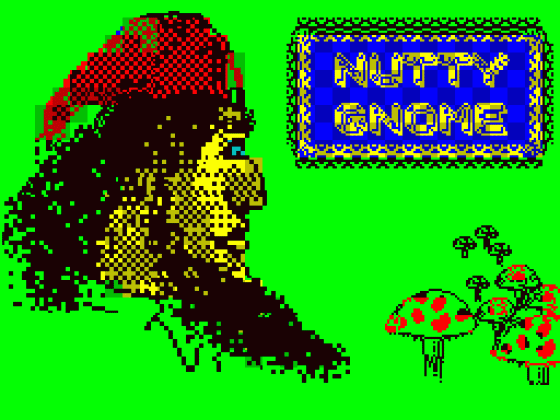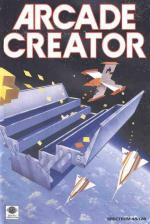
Sinclair User
 9th June 1986
9th June 1986
Author: John Gilbert
Publisher: Argus Press
Machine: Spectrum 48K
Published in Sinclair User #53
Arcade Creator
Produce your own arcade games without getting involved in the intricacies of machine code with the first in a series of creator utilities from Argus Press.
The package includes four tapes, which makes access to the five graphics and sound utilities easier than searching through one long tape. Those utilities give you control over user-defined graphics (UDG) and sprite generation, the creation of sound effects, background screen design and the final compilation of those elements into a stand-alone code game.
There are two types of game you can produce: Levels and Ladders or a Shoot 'Em Up. The former gives you a Jet Set Willy type scenario while the latter is for Space Invaders freaks where killing aliens is the only form of worthwhile entertainment. Both types are created using the same process.

First create your objects using the UDG designer, your main characters using the sprite designer and create the backgrounds you want.
Then assign the UDGs and sprites as objects of various types, eg, players, aliens, treasure. Link the screens together and define the sound effects. Now compile the whole thing on to one tape and the game is complete.
Actually it's not that simple, but it's not impossible either.
The UDG designer produces a still character set which can be used to create treasure icons and the building blocks for the scenery. There are four blocks of UDGs from which you can select defaults, or design your own over existing ones.
Each UDG is designed on an eight-by-eight grid using a joystick or keyboard controlled pen cursor. When you've created your character you can change it using the block move commands. Those mirror the image, rotate it through 90 degrees and invert the Paper and ink colours. Once you've finished your masterpiece you can save it to one of the four banks of UDGs in Ram.
The sprite designer is similar to the UDG utility but the grid is 16x16 and you can only store 16 of them. Unlike UDG characters the sprite images can be animated. You could, for instance, produce a series of frame grids showing a man walking, then flash them onto the screen one at a time using the Arcade Creator's control program. A 'current sprite window' on the file status screen demonstrates the animation of any figures you have created before you put them into a game.
You can give your sprite characters one of four Paper colours and eight ink colours. Those are chosen from a menu using an arrow cursor - all mod cons - and activated instantly by pressing fire.
Sprites can be moved around in their squares in a similar way to UDGs but the benefits of mirror, invert and rotate are more obvious than for UDGs. Many of your characters will, for instance, want to move left and right which could mean that you have to create two sprites, one for each direction. You don't, of course, have to do that. Just create one sprite and flick its mirror image into a free sprite grid. While you're at it you could get your figure to walk up the walls by rotating it by 90 degrees.
Once you've finished the animated bits you'll need a background for them to play in Arcade Creator has a very basic screen designer which you can use to create all the levels and ladders you need.
Start off with a yellow flashing cursor in the middle of a blank display window. Below are the characters you can use to build your scaffolding and status displays which show the co-ordinates of the cursor and the file number of the screen. You can store more than eight screens in memory and the package shows how many bytes you have left for other screens.
All arcade games need some sound effects to evoke an atmosphere in keeping with the plot. Arcade Creator has a limited sound system which produces beeps or white noise.
Sound effects are created using three parameters: frequence, length and repetition. The frequency of the note is split further into start value, end value and the step of the scale up or down between those two points.
The package includes eight preset sound effects which can be ranged from sharp to mellow. The utility is interactive so you can test your sounds while in the development stage and make alterations if they don't fit your requirements.
When you've set up the graphics and sound you can save all the data to tape ready for the compilation process. The program first asks you to load in the graphics and sound information for your new game.
Those prompts are followed by requests for the number of lives, the name given to 'bonus' points and the starting value of those points. You can also set the game so that every time the character runs out of bonus points you lose a life.
Now set up the types of sprite you want. The package gives names to each type including Player, Missile, Aliens and Bombs. For instance, you could use a little person for Player, a blob for treasure and a bag of gold for bombs.
Once you've set up the number of sprites and defined their shapes you'll need to decide what will happen to them and whether they can use bombs. The program also allows access to multi-coloured sprites which change hue as they move around.
The sound is the last aspect to be dealt with before everything is compiled on to tape. You can put sound anywhere at the start of a new level, or where treasure is collected or even when a missile is fired to five added effect to the action.
Then save everything to tape and load in the file utility. The Game Code generator adds a preselected tune and loading screen, and saves your game which you can then load back without needing Arcade Creator in memory.
Arcade Creator is easy to use and produces competent games - though just how good depends upon the user. An example game included in the package doesn't exploit its potential power, but no doubt some impressive games could be created by anyone with a good imagination.
There's no other package on the Spectrum to rival Adventure Creator. HURG from Melbourne House and Games Designer from Quicksilva both require the development system in memory when you play the games. The Argus package has no such drawback.
OK, so the final game isn't going to be earth-shattering. But it'll be playable and won't require you to have any knowledge of machine-code.
Label: Argus Press Price: £14.95 Joystick: Kempston Memory: 48K/128K Reviewer: John Gilbert
*****
Overall Summary
A peerless Spectrum utility. No machine code experience required to create standalone arcade games.













